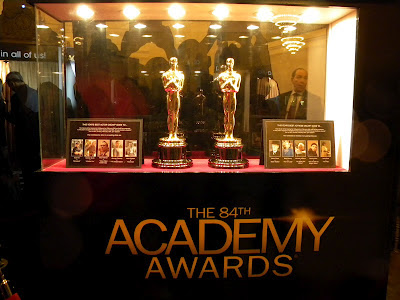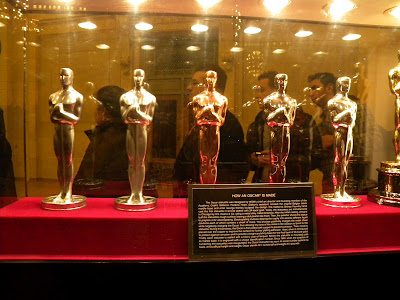An Academy Award is an award bestowed by the American Academy of Motion Picture Arts and Sciences (AMPAS) to recognize excellence of professionals in the film industry, including directors, actors, and writers. The Oscar statuette is officially named the Academy Award of Merit and is one of nine types of Academy Awards. The formal ceremony at which the Awards of Merit are presented is one of the most prominent award ceremonies in the world, and is televised live in more than 100 countries annually, however the first broadcast was not televised. It is also the oldest award ceremony in the media; its equivalents, the Grammy Awards (for music), Emmy Awards (for television), and Tony Awards (for theatre) are modeled after the Academy.
The AMPAS was originally conceived by Metro-Goldwyn-Mayer studio boss Louis B. Mayer as a professional honorary organization to help improve the film industry’s image and help mediate labor disputes. The Oscar itself was later initiated by the Academy as an award "of merit for distinctive achievement" in the industry.
The first Academy Awards ceremony was held on May 16, 1929, at the Hotel Roosevelt in Hollywood to honor outstanding film achievements of the 1927/1928 film season. The most recent ceremony, honoring films in 2010, was held at Hollywood's Kodak Theatre on February 27, 2011. The 84th Academy Awards, honoring films in 2011, will be held at the Kodak Theatre on February 26, 2012.
Design
Although there are seven other types of annual awards presented by the Academy (the Irving G. Thalberg Memorial Award, the Jean Hersholt Humanitarian Award, the Gordon E. Sawyer Award, the Scientific and Engineering Award, the Technical Achievement Award, the John A. Bonner Medal of Commendation, and the Student Academy Award) plus two awards that are not presented annually (the Special Achievement Award in the form of an Oscar statuette and the Honorary Award that may or may not be in the form of an Oscar statuette), the best known one is the Academy Award of Merit more popularly known as the Oscar statuette.
Made of gold-plated britannium on a black metal base, it is 13.5 in (34 cm) tall, weighs 8.5 lb (3.85 kg) and depicts a knight rendered in Art Deco style holding a crusader's sword standing on a reel of film with five spokes. The five spokes each represent the original branches of the Academy: Actors, Writers, Directors, Producers, and Technicians.
In 1928, MGM's art director Cedric Gibbons, one of the original Academy members, supervised the design of the award trophy by printing the design on a scroll. In need of a model for his statuette, Gibbons was introduced by his future wife Dolores del Río to Mexican film director and actor Emilio "El Indio" Fernández. Reluctant at first, Fernández was finally convinced to pose nude to create what today is known as the "Oscar". Then, sculptor George Stanley (who also did the Muse Fountain at the Hollywood Bowl) sculpted Gibbons's design in clay and Sachin Smith cast the statuette in 92.5 percent tin and 7.5 percent copper and then gold-plated it.
The only addition to the Oscar since it was created is a minor streamlining of the base. The original Oscar mold was cast in 1928 at the C.W. Shumway & Sons Foundry in Batavia, Illinois, which also contributed to casting the molds for the Vince Lombardi Trophy and Emmy Awards statuettes. Since 1983, approximately 50 Oscars are made each year in Chicago by Illinois manufacturer R.S. Owens & Company.
In support of the American effort in World War II, the statuettes were made of plaster and were traded in for gold ones after the war had ended.
Naming
The root of the name Oscar is contested. One biography of Bette Davis claims that she named the Oscar after her first husband, band leader Harmon Oscar Nelson; one of the earliest mentions in print of the term Oscar dates back to a Time magazine article about the 1934 6th Academy Awards. Walt Disney is also quoted as thanking the Academy for his Oscar as early as 1932.
Another claimed origin is that the Academy's Executive Secretary, Margaret Herrick, first saw the award in 1931 and made reference to the statuette's reminding her of her "Uncle Oscar" (a nickname for her cousin Oscar Pierce). Columnist Sidney Skolsky was present during Herrick's naming and seized the name in his byline, "Employees have affectionately dubbed their famous statuette 'Oscar'". The trophy was officially dubbed the "Oscar" in 1939 by the Academy of Motion Pictures Arts and Sciences.
Another legend reports that the Norwegian-American Eleanor Lilleberg, executive secretary to Louis B. Mayer, saw the first statuette and exclaimed, "It looks like King Oscar II!". At the end of the day she asked, "What should we do with Oscar, put him in the vault?" and the name stuck.
I, (sookietex) the creator of this work, hereby release it into the public domain. This applies worldwide. In case this is not legally possible, I grant any entity the right to use this work for any purpose, without any conditions, unless such conditions are required by law.
If These images is subject to copyright in your jurisdiction, i (sookietex) the copyright holder have irrevocably released all rights to it, allowing it to be freely reproduced, distributed, transmitted, used, modified, built upon, or otherwise exploited in any way by anyone for any purpose, commercial or non-commercial, with or without attribution of the author, as if in the public domain. +sookie tex
TEXT CREDIT: Wikipedia From Wikipedia





No comments:
Post a Comment